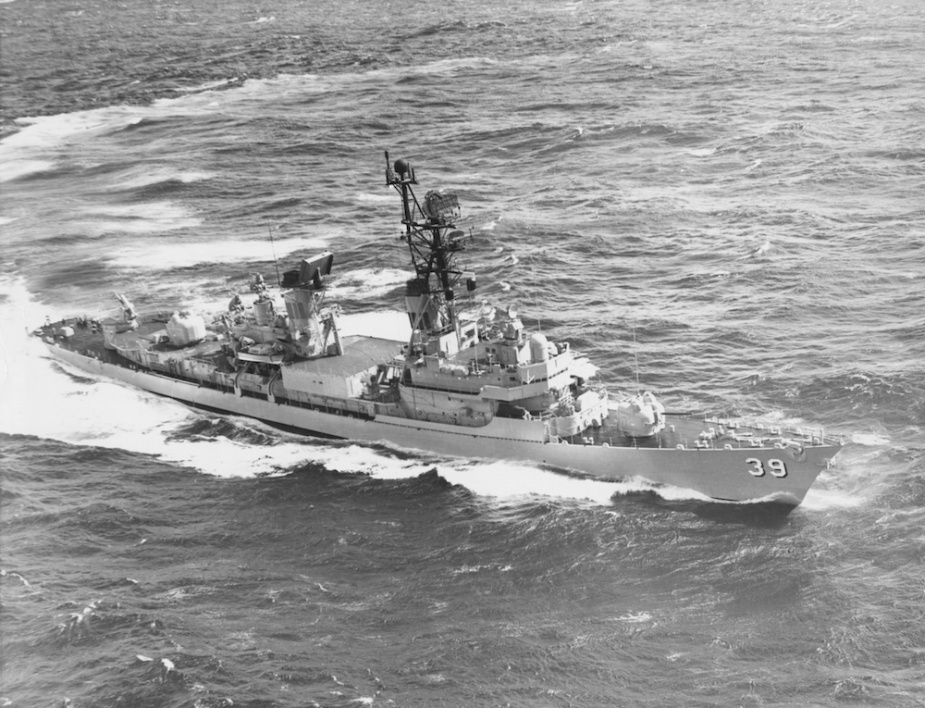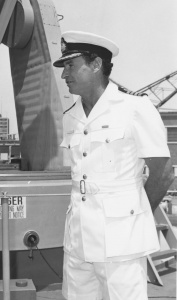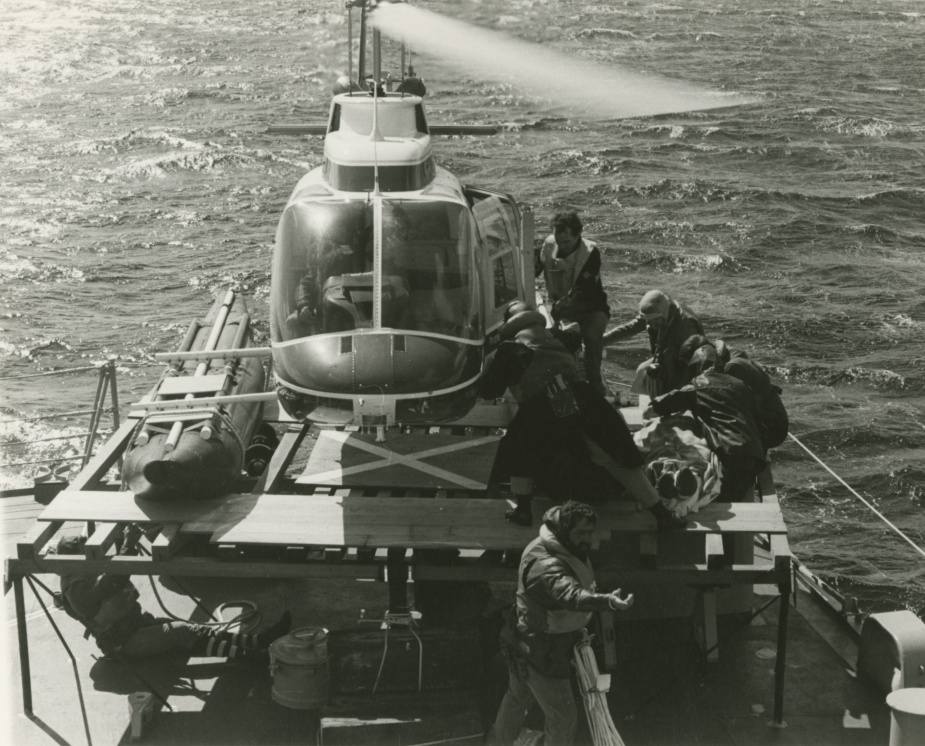Naval Ingenuity: A Case Study
Throughout history, seafarers have had to consistently use their ingenuity to improvise, adapt and overcome in the face of adversity. The very nature of ships is such that when they sail and the ‘umbilical cord’ connecting them to shore infrastructure is cut, they become dependant upon their own provisions and resources. Notwithstanding the technological advantages enjoyed today by mariners the world over, this truism remains.
It was certainly the case in January 1979 when the Perth Class Guided Missile Destroyer (DDG) HMAS Hobart closed up at ‘flying stations’, and in a world first prepared to land a helicopter onboard a hastily constructed helicopter pad situated on her quarterdeck. The story of this historic event is but one example of the type of initiative and resourcefulness displayed by officers and sailors serving in the Royal Australian Navy (RAN). It remains a fine example of naval ingenuity.
On 4 January 1979, Hobart, under the command of Captain PGN Kennedy, RAN, was berthed outboard of the destroyer tender HMAS Stalwart in Sydney, undergoing an Assisted Maintenance Period. With much of her machinery and vital equipment in pieces, and with many of her crew still absent on Christmas leave, the possibility of sailing within 24 hours seemed remote. However, when orders were received to standby to sail for an urgent medical evacuation task at Macquarie Island in the Southern Ocean, the ship responded to the first of a series of obstacles that were to be encountered throughout the mission.
As further details of the tasking were received, the full extent of Hobart’s mercy mission became apparent. It was learned that Mr Roger J Barker, a biologist working as part of Australia’s Antarctic Expedition on Macquarie Island, had fallen 200 feet down a cliff face while studying bird life, and that he had sustained extensive spinal and leg injuries. Although he had been recovered from the scene of the accident and was receiving first aid, it was clear that he required urgent specialist medical treatment and that he would need to be evacuated to the nearest hospital, some 900 miles to the north west in Hobart, Tasmania. Hobart was consequently briefed to make preparations to steam south with all dispatch and evacuate Mr Barker from Macquarie Island to Tasmania.
The first of the obstacles that Hobart’s command faced was to bring the destroyer to a state of immediate readiness for sea and the second challenge was to assemble a crew. A number of essential Hobart personnel were recalled from their leave, while other RAN vessels alongside Garden Island and several shore establishments contributed members of their duty watches to complement her depleted ship’s company. A further obstacle was to restore vital machinery to working condition. As this work went on Hobart fuelled throughout the afternoon and evening of 4 January at which time confirmation of the mission was received from Fleet Headquarters. With final preparations continuing throughout the morning of 5 January, Hobart sailed from Sydney at 15:00, on one boiler and short 100 men from her usual complement of 333. As she made her way through Sydney Heads the second of her four boilers was brought on line with the remaining two being flashed up off Jervis Bay and Gabo Island respectively. With full power now available, Hobart proceeded with dispatch on the 1340 mile mercy dash to Macquarie Island.
In the meantime, the antarctic support vessel MV Thala Dan was only twelve hours steaming from the port of Hobart. The Thala Dan was directed to put into Hobart, disembark her passengers and take on a helicopter chartered by the Antarctic Division to assist in the rescue.
The following day, Hobart established direct communications with Macquarie Island and a full medical update on Mr Barker’s condition was received. Having fallen from the cliff face, Mr Barker had spent four agonising hours lying on his stomach trying to stop skuas from pecking at his injuries before he was rescued.[1] Grave concerns were held for his well being and it was unclear what the best method of transferring him to Hobart would be, in light of deteriorating weather conditions at Macquarie Island.
On Sunday 7 January a three way communications link was established between Hobart, the Thala Dan, and the Macquarie Island base. Transfer options were discussed with the pilot of Thala Dan’s small utility helicopter, Nigel Osborn who, as luck would have it, was an ex-Royal Navy pilot. It was agreed that a makeshift helicopter pad should be constructed onboard Hobart to enable transfer of the patient by air in the event that weather conditions at Macquarie Island were unsuitable for a boat transfer.
Throughout the day, Hobart found herself in rapidly deteriorating weather, with a fifteen foot swell running and the wind registering a constant force seven (28-33 knots). A number of her crew, particularly those who had been seconded for the voyage and who were not accustomed to the pitching and rolling of a DDG, experienced great discomfort as the ship steamed steadily south. In spite of this, the destroyer’s shipwrights, engineers and seamen commenced work on the construction of the helicopter pad on the port side of Hobart’s quarterdeck, using only the material and expertise available onboard. By the end of the day they had skilfully assembled a stout platform and were reasonably confident that it would be capable of receiving Thala Dan’s helicopter should the need arise.
At 05:15 on Monday 8 January, Macquarie Island was raised on radar and shortly afterwards Hobart altered her course to pass between the Judges and Clerk Islands as she proceeded to rendezvous with Thala Dan in Buckles Bay. On arrival in Buckles Bay at 08:54, Hobart anchored two and a half cables to seaward of Thala Dan where an immediate assessment was made on how best to transfer the injured scientist. Hobart was rolling up to 12 degrees with the wind gusting between 30 and 35 knots, while the choppy sea state was estimated to be between three and four feet in height. Notwithstanding the shelter offered within the bay, it was obvious that it would be much too hazardous to attempt a boat transfer and risk further injury to the patient in such conditions. Thus the decision was made to transfer the patient using Thala Dan’s helicopter.
Within half an hour Hobart was closed up at ‘flying stations’ and Thala Dan’s helicopter was called in to attempt a trial landing on the recently constructed helipad. The landing was timed to avoid periods of excessive rolling and at 09:30 the helicopter landed safely on board the makeshift structure. With the trial complete attention now turned to the medical evacuation of Mr Barker, which began at 10:02 following the passing of a heavy rain squall. Again the helicopter was called in and the transfer was successfully completed in approximately 60 seconds.[2] With the patient and an Antarctic Division medical officer safely on board Hobart, the helicopter returned to Thala Dan with the distinction of being the first aircraft to land on board a Perth Class DDG.
Hobart weighed anchor without delay and once clear of the island set course at best speed for the 900 mile voyage to Hobart. Mr Barker handled the rough sea conditions well throughout Monday 8 January and the forenoon of the following day; however, concern over a deterioration in his condition necessitated an increase in speed in spite of the weather. The Derwent River was entered at 23:40 on Tuesday 9 January and Hobart berthed alongside Macquarie Wharf at 01:15 on Wednesday morning, completing the journey in a record 39 hours. Shortly after berthing, Mr Barker was transferred to a waiting ambulance and taken to the Royal Hobart Hospital.
Throughout the transit from Macquarie Island to Hobart, it was reported that the injured Roger Barker displayed great courage and remained composed in spite of his terrible injuries. He underwent emergency surgery on arrival in hospital at Hobart, which sadly resulted in the amputation of his left leg. It was with deep regret that the crew of Hobart later learned that he lost his fight for life when he succumbed to his injuries in Melbourne on 8 February 1979.[3] As a tribute to Roger Barker, the Barker Channel in the Vestfold Hills region of Australian Antarctic Territory was subsequently named in his honour.
Hobart’s mercy dash in 1979 typifies both the character and compassion of the Australian sailor. Her ‘scratch’ crew’s willingness to put service before self to assist someone in great need, coupled with their ability to improvise in the face of adversity continues to serve as a fine example of naval ingenuity.






